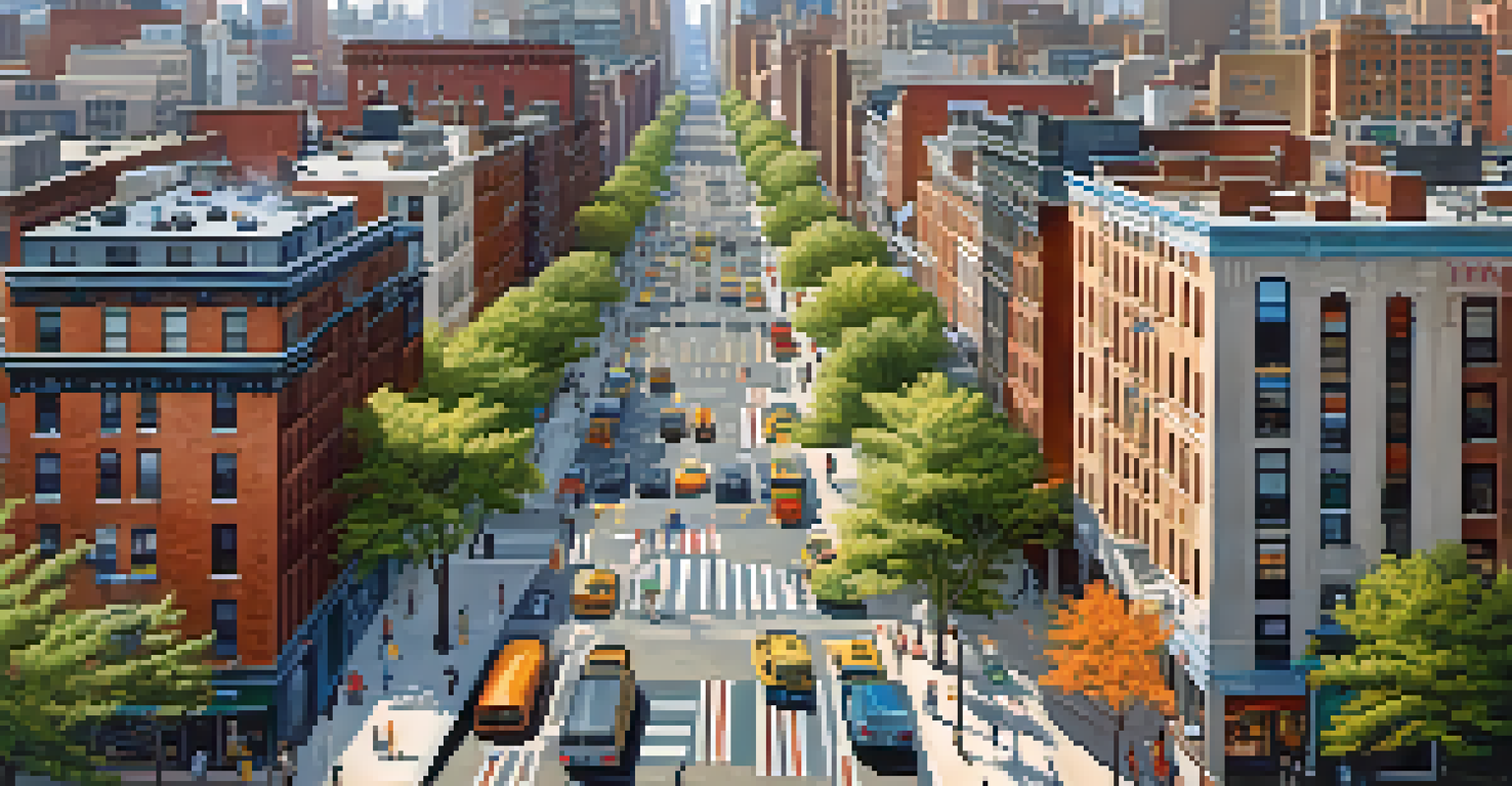Shifts in Demographics Affecting NYC Real Estate Market Trends

Understanding NYC's Evolving Demographics
New York City is a vibrant tapestry of cultures, and its demographics are constantly changing. Over the past decade, we've seen shifts in population due to various factors like migration, economic opportunities, and lifestyle choices. Understanding these changes is crucial, as they directly influence the real estate market.
In any city, the way people live, work, and interact is always changing, and those shifts shape the neighborhoods we call home.
For instance, younger generations are increasingly moving into urban areas, seeking the excitement and convenience that cities offer. This trend not only affects the types of properties in demand but also the neighborhoods that are experiencing a surge in popularity. Areas that were once overlooked are now becoming hot spots for young professionals and families.
Moreover, the aging population is also a significant factor, with many seniors looking to downsize or relocate to more accessible areas. This demographic shift is prompting a rise in demand for specific housing types, such as co-ops and senior living communities, highlighting the need for adaptability in real estate offerings.
The Impact of Remote Work on Housing Demand
The COVID-19 pandemic has fundamentally transformed the way we work, leading to a rise in remote work opportunities. This shift has allowed many individuals to reconsider where they live, often moving away from traditional urban centers to suburban or rural areas. As a result, urban real estate markets like NYC are experiencing fluctuations in demand.

For example, while some neighborhoods in Manhattan may see a decline in rental prices, areas further out with more space and better amenities are becoming increasingly attractive. This new preference for larger living spaces has created a ripple effect on the types of properties that are now in high demand, reshaping the real estate landscape.
Shifting Demographics Shape NYC Real Estate
The evolving demographics in NYC, driven by factors like migration and changing family structures, are significantly influencing the types of housing in demand.
Additionally, this trend has prompted developers to rethink their projects, focusing on creating remote work-friendly environments with dedicated home office spaces. As the work-from-home model continues to evolve, the real estate market must adapt to meet the changing needs of its residents.
Shifts in Family Structures and Their Impact
The traditional family structure is changing, with more single professionals, blended families, and multi-generational households emerging. These shifts directly affect the types of housing that are in demand within NYC. For example, single professionals might prioritize studio apartments in vibrant neighborhoods, while families may seek larger units with more amenities.
Diversity is not a reason for division; it is a strength that can revitalize communities and create new opportunities.
As we see an increase in cohabitation and alternative living arrangements, the need for flexible living spaces is becoming more pronounced. This has led to a rise in the popularity of buildings that offer shared amenities and community features, catering to a diverse range of household types.
Real estate developers are taking note of these changes and are now designing properties that accommodate a variety of family structures. This adaptability can help ensure that the housing market remains relevant and appealing to a broader audience.
Cultural Diversity and Neighborhood Revitalization
New York City is known for its rich cultural diversity, and this has a profound impact on neighborhood dynamics and real estate trends. As new immigrant populations settle in different areas, they bring unique cultural influences that can revitalize communities. This revitalization often leads to increased investment in local businesses and infrastructure.
For instance, neighborhoods like Astoria and Jackson Heights have seen a surge in popularity due to their diverse populations, which in turn attracts new residents and investors. This influx can lead to rising property values and rental prices, changing the landscape of these communities.
Remote Work Influences Housing Trends
The rise of remote work is causing individuals to seek larger living spaces outside traditional urban centers, impacting rental prices and property types.
The blend of cultures not only enriches the community but also creates unique real estate opportunities. Developers are increasingly recognizing the value of these vibrant neighborhoods, leading to a focus on creating culturally relevant spaces that appeal to both new and existing residents.
Economic Factors Influencing Demographic Changes
Economic conditions play a crucial role in shaping demographic trends within NYC. Factors such as job availability, wage growth, and the cost of living all influence where people choose to live. When the economy is thriving, we often see an influx of young professionals moving to the city, seeking new opportunities.
Conversely, during economic downturns, we might witness a migration to more affordable areas, as individuals reassess their housing situations. This ebb and flow directly impacts the real estate market, leading to shifts in demand for various types of properties across the city.
Understanding these economic drivers is essential for real estate professionals. By staying informed about economic trends, they can better anticipate shifts in demand and adjust their strategies accordingly, ensuring they meet the needs of a changing population.
The Role of Technology in Housing Preferences
As technology continues to advance, it has a significant impact on housing preferences and the real estate market as a whole. From smart home features to virtual tours, the way we buy and sell properties has evolved dramatically. Today's buyers are increasingly looking for tech-savvy homes that can enhance their living experience.
For instance, younger generations prioritize homes with integrated technology, such as energy-efficient appliances and smart security systems. This demand is prompting developers to incorporate these features into their projects, making them more appealing to tech-savvy buyers.
Cultural Diversity Revitalizes Neighborhoods
New immigrant populations are revitalizing NYC neighborhoods, leading to increased investment and changing real estate dynamics.
Moreover, technology has also changed how real estate transactions are conducted. Virtual tours and online listings have made it easier for buyers to explore properties without needing to visit in person, which is particularly appealing in a fast-paced market like NYC. This shift not only enhances convenience but also broadens the pool of potential buyers.
Future Trends in NYC Real Estate Due to Demographics
Looking ahead, it’s clear that the demographic shifts we’re witnessing will continue to influence the NYC real estate market. As the population becomes more diverse and family structures evolve, we can expect to see an ongoing demand for varied housing options that cater to different lifestyles. This could mean more mixed-use developments and community-oriented spaces.
Additionally, the trend towards remote work and flexibility is likely to remain, prompting developers to create homes that accommodate both work and leisure. This shift may also lead to an increased focus on outdoor spaces as people seek environments that promote well-being and work-life balance.

Ultimately, those involved in the real estate market must stay attuned to these demographic changes. By anticipating shifts and adapting to the evolving needs of residents, they can ensure that NYC remains a dynamic and attractive place to live.